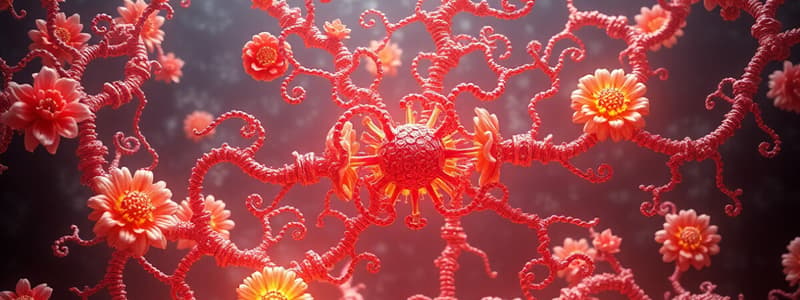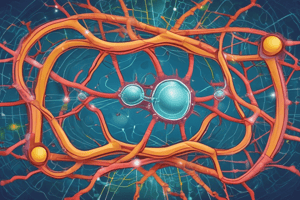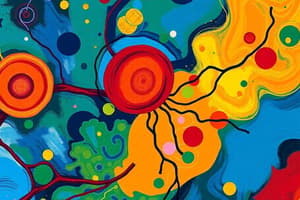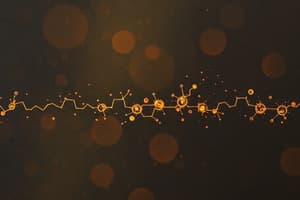Podcast
Questions and Answers
_____ phosphorylation as the name implies two separate processes:
_____ phosphorylation as the name implies two separate processes:
Oxidative
What two separate processes does oxidative phosphorylation involve?
What two separate processes does oxidative phosphorylation involve?
Redox reactions and phosphorylation
Does the Electron Transport Chain (ETC) make ATP?
Does the Electron Transport Chain (ETC) make ATP?
False (B)
Who explained the process of chemiosmotic theory?
Who explained the process of chemiosmotic theory?
What does PMF stand for and what role does it play?
What does PMF stand for and what role does it play?
How do protons get inside the mitochondrial membrane?
How do protons get inside the mitochondrial membrane?
How many major aspects does oxidative phosphorylation have?
How many major aspects does oxidative phosphorylation have?
Name three types of electrons transfer through the electron transport chain?
Name three types of electrons transfer through the electron transport chain?
What is another name for Ubiquinone?
What is another name for Ubiquinone?
Ubiquinone is lipid-soluble _______ with a long isoprenoid side chain
Ubiquinone is lipid-soluble _______ with a long isoprenoid side chain
Cytochromes function as electrons carriers.
Cytochromes function as electrons carriers.
Each cytochrome in its reduced (Fe+2) state has how many absorption bands in the visible range?
Each cytochrome in its reduced (Fe+2) state has how many absorption bands in the visible range?
Cytochromes a, b, and c are transmembrane, with 'c' being the exception.
Cytochromes a, b, and c are transmembrane, with 'c' being the exception.
What is the job of iron sulfur clusters?
What is the job of iron sulfur clusters?
What are the two sources of electrons (electron donor)?
What are the two sources of electrons (electron donor)?
What is the final acceptor of electron?
What is the final acceptor of electron?
The inner mitochondrial membrane is permeable to anything charged even to H+.
The inner mitochondrial membrane is permeable to anything charged even to H+.
The outer membrane is similar to cell membrane and have what % of cardiolipin?
The outer membrane is similar to cell membrane and have what % of cardiolipin?
In other words: matrix contains all pathways of fuel oxidation except what?
In other words: matrix contains all pathways of fuel oxidation except what?
Flashcards
Oxidative phosphorylation
Oxidative phosphorylation
As the name implies it involves two separate processes: Redox reactions (oxidation and reduction) and Phosphorylation (produce of ATP using ATP synthase).
Chemiosmotic Theory
Chemiosmotic Theory
Scientist, Peter Mitchell, explained this process as electrons moving according to their reduction potential, energy from this movement pumps H+ ions creating a proton motive force.
PMF
PMF
Proton motive force plays a role and links between the movement of electrons and ATP synthesis.
Types of electron transfer
Types of electron transfer
Signup and view all the flashcards
Ubiquinone
Ubiquinone
Signup and view all the flashcards
Cytochromes
Cytochromes
Signup and view all the flashcards
Iron-sulfur clusters (Fe-S)
Iron-sulfur clusters (Fe-S)
Signup and view all the flashcards
Inner mitochondrial membrane
Inner mitochondrial membrane
Signup and view all the flashcards
Krebs Cycle Location
Krebs Cycle Location
Signup and view all the flashcards
Complex I Role
Complex I Role
Signup and view all the flashcards
Study Notes
- Oxidative phosphorylation involves redox reactions using the electron transport chain and phosphorylation, producing ATP via ATP synthase.
- Oxidative part is needed to make the phosphorylation part.
- Peter Mitchell explained the process (chemiosmotic theory).
- Electrons move from more negative to more positive reduction potentials.
- Energy difference in electrons movement helps pump H+ from the matrix to the intermembranous space, against their gradient.
- Proton motive force (PMF) connects electron movement and ATP synthesis.
- High proton concentration outside the mitochondria membrane creates pressure, but protons can only enter through ATP synthase.
- Generation of ATP is aided by O2 reduction.
- Oxidative phosphorylation has three aspects:
- Electron flow through membrane-bound carriers.
- Free energy (exergonic) is coupled to transport protons across a proton-impermeable membrane.
- Transmembrane proton flow down the concentration gradient provides free energy for ATP synthesis.
Electron Transfer Types
- Direct electron transfer, as in Fe+3 to Fe+2 reduction.
- Transfer as a hydrogen atom, like in FADH2.
- Transfer as a hydride ion (H-), like in NAD+.
- Stages include: Digestion; Acetyl-CoA, TCA, OxPhos
Electron-Carrying Molecules
Ubiquinone
- Also called coenzyme Q or Q.
- Lipid-soluble benzoquinone with a long isoprenoid side chain.
- Cyclic diene structure has 2 keto (carbonyl) groups, which contribute to Reduction reaction and produce ubiquinol (Alcohol).
- It’s small and hydrophobic (freely diffusible).
- Works as electron carrier in the IMM.
- Accepts 1 or 2 electrons as hydrogen atoms sequentially.
- Hydrocarbon chain makes it hydrophobic enabling it to pass the membrane; mix structure found in membrane accepting electrons.
- Junction between 2 electron donor and 1 electron acceptor.
Cytochromes
- Heme groups act as electron carriers.
- Proteins with strong visible light absorption (Fe-containing heme prosthetic groups).
- Classification based on light absorption and mode of binding (a, b, c).
- Mitochondria have three cytochrome classes (a, b, c).
- Heme ΔE varies.
- Each reduced cytochrome (Fe+2) has 3 absorption bands in the visible range.
- α band: near 600 nm in type a; near 560 nm in type b; near 550 nm in type c.
- Cytochromes named by α band wavelength: Cytochrome b562, Cytochrome C550, Cytochrome C551.
- Heme carries one electron.
- ΔEº' depends on the protein.
- Cytochromes a, b & c are transmembrane (c is the exception).
Iron-Sulfur Clusters (Fe-S)
- Have structures inside proteins.
- Pick up and deliver electrons, like FAD, FMN, and metals.
Oxidative Phosphorylation Requirements
- Electron source (NADH and FADH2).
- ETC of proteins, electron-carrying molecules.
- Final electron acceptor (oxygen).
- ATP synthase.
- Intact IMM.
- Inner mitochondrial membrane is impermeable to charged molecules, including H+.
- Impermeability is due to cardiolipin that prevents passing any molecule. It's 22% in inner membrane, also there is no Cholesterol.
- Outer membrane is similar to cell membrane with 3% cardiolipin and 45% cholesterol.
Mitochondria
- OMM: permeable to small molecules (MW<5,000) and ions via porins (transmembrane channels).
- IMM: impermeable to H+; specific transporters.
- IMM contains the respiratory chain and ATP synthase.
- Matrix: contains pyruvate dehydrogenase complex, TCA cycle enzymes, fatty acid β-oxidation pathway, and amino acid oxidation pathways.
- Matrix contains all fuel oxidation pathways except glycolysis (cytosol).
- The Krebs cycle occurs in the mitochondrial matrix, producing NADH and FADH2.
- NADH donates 2 electrons to complex one, becomes NAD+, and is catalyzed by NADH Dehydrogenase.
- Electrons move to FMN, then Fe-S in complex one, and reach Ubiquinone.
- Enzymes function as oxidoreductases because they contain molecules that accept and donate electrons (FMN, Fe-S clusters, Copper, etc.).
- Electrons moving from complex 1 to ubiquinone produce ubiquinol.
- Other names for complex 1: NADH-Q oxidoreductase & NADH dehydrogenase
- Electrons move to complex 3 via Complex 1 through NADH (more used) and Complex 2 through FADH2
- Complex 3 receives electrons from 2 sources via ubiquinone.
- FADH2 is a product of the Krebs cycle, which consists of 8 steps & 8 enzymes. 7 of them in the matrix and one suspended in the inner mitochondrial membrane.
- In the sixth step, succinate becomes fumarate (by succinate dehydrogenase/succinate CoQ Oxidoreductase), producing FADH2.
- 2 electrons from NADH and 2 electrons from FADH2 arrive at complex 3.
- Then, via cytochrome c, they go to complex 4 receiving 1 electron at a time. Complex 4 contains 2 Cu atoms and 2 heme types (Hem a and Hem a3).
- NADH: Complex I → Coenzyme Q → complex III → Cytochrome c → complex IV→ O2
- FADH2: Complex II → Coenzyme Q → complex III → Cytochrome c → complex IV→ O2
Studying That Suits You
Use AI to generate personalized quizzes and flashcards to suit your learning preferences.




